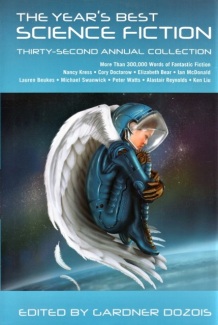After Dark (novel) by Haruki Murakami
English Publication History: After Dark (Alfred K. Knopf, 2007; Vintage, 2007; Bond Street, 2007; Harvill Secker, 2007; Thorndike, 2007; Anchor, 2013)
Original: Japanese (2004, アフターダーク)
Translated by Jay Rubin, 2004
Synopsis: Alone but not outwardly lonely, a girl sits in a restaurant reading a book. Though the time nears midnight, she seems unhurried to catch the last train home as with so many others in the city of millions. Outwardly, again, she’s just face in a restaurant; she’s one of a million of women in one of a score of Denny’s in one of the world’s largest cites: Tokyo. Here, nothing in unique. Only when a male passerby identifies her does she earn attention… and a name and a relationship: Mari, the sister of the Eri, who the passerby knows as an acquaintance. With identities established, the two go their separate ways.
Soon, Mari is approached by another unfamiliar face who is an acquaintance of the prior man. Considering Mari to be fluent in Chinese, she woman elicits help in order to deal with a situation stemming from an injured Chinese prostitute at a love hotel. Mari then descends into the seedier side of city complete with mafia, johns, and those who find employment on the operations side of such establishments. Regardless of the chasm between their current lives and backgrounds, Mari finds a familiar air of association with the prostitute, the hotel’s manageress, and the assistant; however, there are those amid the night’s secretive pervasiveness who elude Mari’s scope of relevance: the mafia figure who picks up the prostitute and the unnamed john who assaulted the same prostitute.
As the night deepens, Mari experiences the depth of those with whom she comes into contact. Like effervescence, life emerges to the surface, popping in Mari’s mind with chromatic intrigue, compelling her to disclose her own history, albeit slowly and sparsely. Divulging mostly to Takahashi, the man who recognized her in the Denny’s, Mari opens up her familial history regarding Eri, a beautiful but elusive sister, one who has led her own life both in limelight and recent hermitage. Though Mari tells her story, she resists baring her soul, which seems caged by the non-existence of her relationship with Eri.
Meanwhile…
…Eri sleeps peacefully, a static body of beauty and dreamstate. Her unplugged TV stirs to life portraying a translucently masked man who silently observes as he sits in the middle of a wide open floorspace. Soon, he disappears while Eri is ethereally transported to the same space, where she wakens to a self-induced panic; exhausted though, she settles once again into slumber.
…the john who attacked the prostitute hammers out computer code in his open office. Shirakawa’s meaningless work reflects his errant way of life, one transfixed on remorseless debauchery and emotionless family life. His so-called follows through its motions as a pendulum swings: predictable yet ripe with gravitational potential.
Analysis: During our waking hours, we live in the realm of civilization; if not working with, commuting with, or co-inhabiting with our fellow humans, we’re at least exposed to the product of the same civilization in the forms of television, music, literature, furniture or even the city’s sound pollution. When dusk gives way to starlight, when humans return to the safety of home, our body clocks wind down to an obverse alarm, one which incites a return to slumber. With eyes closed, our minds recede inward–further, further–into the depths of our selves, wholly leaving behind civilization. Asleep, we are alone–alone, finally–with only our histories and unconscious associative thoughts.
Rather than a placid lake of reflection, our dreamstate selves wonder amid the unforgiving terrain of thought, complete with streams of thought, quagmires of lost love, oceans of personal history, and other such analogous geography (you get the point). Lost amid the geography of the mind, we are actually confronted by our selves. Subjective truth lies near here in his topography, a trove of which is entirely absent during the day’s tumult. On rare occasions, epiphanies way well forth, suddenly exposing a truth like rare ore that glimmers in the long-hidden sun.
As for Mari, she ignores the truth that dreams ensure. Stalwart to such truth, she stays awake through the night immersed in her outward solitude while shunning the inward solitude of sleep. The night, however, can be just as illuminating as a dream because the city, too, sleeps. While Tokyo recovers from its daily organization of chaos averted, its nocturnal cells replenish its character, a city that seeks its own truths just as humans do. One of these truths is one of its citizens: Mari. With each person she meets, Mari is able to see the shifting facets of herself, which brings her closer to the kernel of her sororal dilemma with Eri.
Eri, in her months-long catatonia, finds herself dreaming, and in that dream, experiences herself as she acted in her real life: self-obsessed. Serene she may lie, but her mind stirs with roiling realization. Others view her as physical perfection, attention which she considers to be of primary importance, thus creating an self-obsession bent on a steady state of the same perfection; however, this perfection is unhappiness. Her life is empty, a shell.
So, too, does Shirakawa experience his own shell. Perhaps a sociopath even though married, he lives his life under the burning lamps of the city rather than that of the sun. In his nocturnal hermitage, any errant to his routine is an infraction on his sense of steady perfection, something which his work demands in one sense. His one brush with humanity in the depths of night paints a demented picture, yet the fallout doesn’t stop him from returning to his mindless bliss at work, at the mini-mart, in the cab, and at home in front of the TV. Having escaped subjective truth for another night, Shirakawa only hides from the predator that is his history; he, a ripe prey for change.
Unimpeded by other schemes, this hint of things to come takes time to expand in the new morning light, and we attempt to watch it unobtrusively, with deep concentration. The night has begun to open up at last. There will be time until the next darkness arrives. (201)
Review: So very atmospheric, it’s a story that demands association just as dreams compel us to look inward. The story won’t do the work for you, so many may be disappointed that everything isn’t tidily strung together in the conclusion, but the open ending, again, compels us to look again, not only at the details of the story, but inward to our selves. The association lies deep. The novel is a great moment of reflection.
Likewise, the novel really captures the intangible essence of the city after dark, something which I’ve experienced in both Tokyo and Osaka, until 1am at least. Though tapering in vitality, the city retains its pulse, much like our own slumber maintains our heartbeat. The novel oozes authenticity and atmosphere.


























